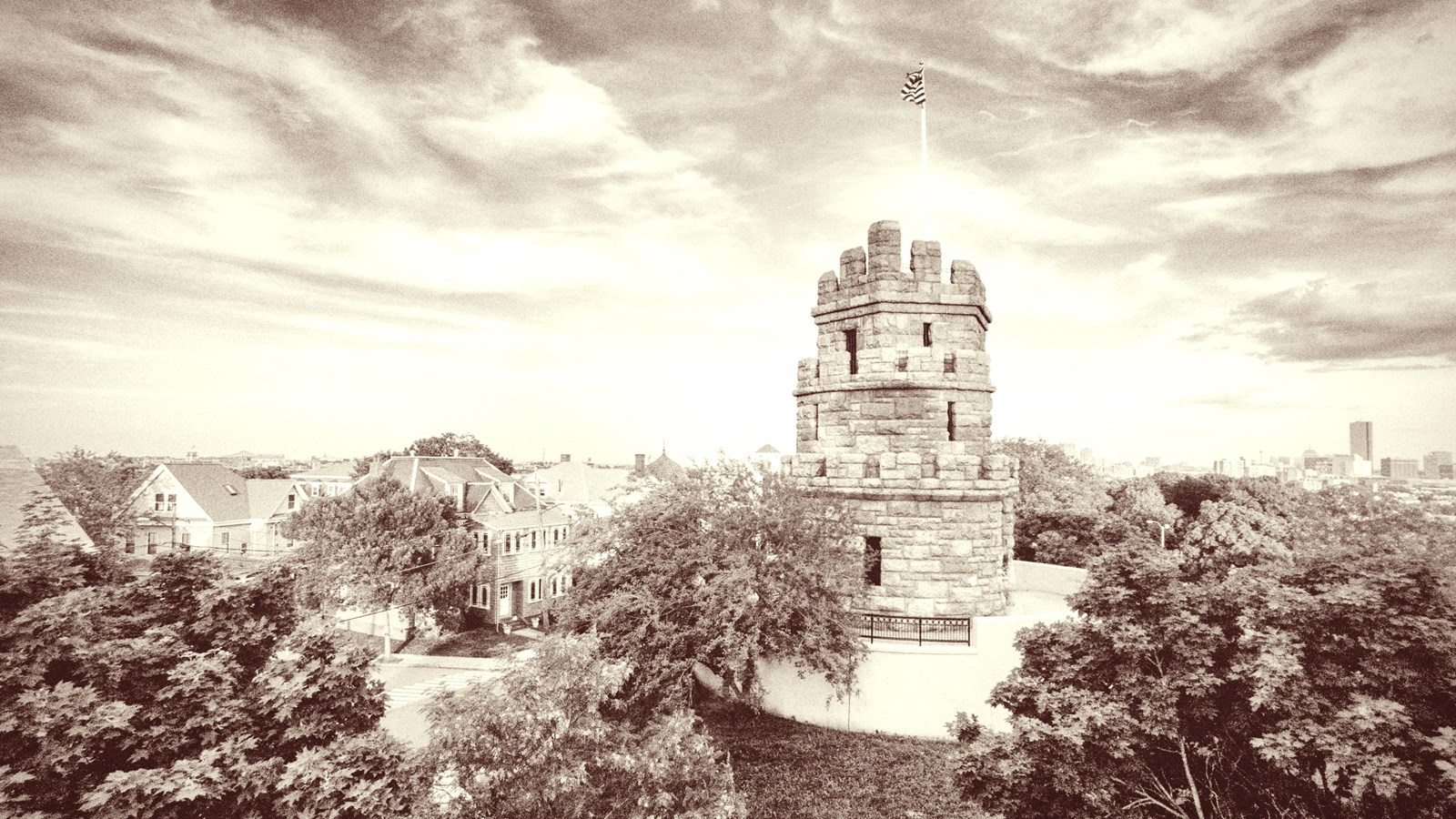Place
Prospect Hill, Somerville

Eric Kilby
Originally part of the town of Charlestown, Massachusetts, Prospect Hill is now located in the nearby town of Somerville. As one of the hills closest to the city of Boston, it played a pivotal role in the line of defensive works constructed after the Battle of Bunker Hill.
Located just 2 ½ miles from Bunker and Breeds Hill, General Israel Putnam led the retreating colonial troops to safety at Prospect Hill. Almost immediately, the men began to fortify the area with a redoubt like the one placed on Breed's Hill on June 17, 1775.1 Over the next nine months, the men stationed at Prospect Hill sustained multiple attacks from the British cannons stationed on the north and west sides of Boston.2
Communications between the Continental Army and British government were, at best, strained. By January 1, 1776, General George Washington received a copy of a speech King George III gave to Parliament on October 26, 1775. During the speech, the King urged a quick end to the "rebellion" in the colonies.3 Writing to Lieutenant Colonel Joseph Reed a few days later, Washington recalled:
We gave great Joy to them (the red Coats I mean) without knowing or intending it, for on that day, the day which gave being to the New Army (but before the Proclamation came to hand) we had hoisted the Union Flag in compliment to the United Colonies...4
Initially intended to provide a moral boost to his soldiers, General Washington inadvertently caused some British soldiers to assume their enemies were surrendering. While there is some disagreement about what specific flag General Washington raised on Prospect Hill in 1776, most scholars believe that it was the Grand Union Flag.5 Containing thirteen alternating stripes of red and white with a Union Jack in the canton, or upper corner, this flag is also considered the First Navy Ensign. By June 14, 1777, the Continental Congress authorized a new flag to replace the Grand Union.6
Between November 1777 and October 1778, the Prospect Hill barracks served as a temporary prison for British prisoners-of-war captured after General John Burgoyne’s surrender at Saratoga, New York. Included in that group was Thomas Walker, a Black drummer with the 29th Regiment. Present at the skirmishes before the Boston Massacre seven years earlier, Walker remained one of only four men from the 29th Regiment still imprisoned. Thomas Walker would later die at the barracks in Lancaster, Pennsylvania on July 18, 1781.7
Though Prospect Hill played a significant role in the early months of the American Revolution, by the 1800s the land had multiple new uses. During the 1860s, Civil War regiments used the land as a training field and campsite. As Somerville grew in population, the land on Prospect Hill began to be subdivided into residential lots. By 1900, the city created a committee to build a monument to commemorate the actions that occurred on the hill during the 1770s. Designed in the style of an English castle and made of granite and surrounded by a public park, the completed structure opened to the public in October 1903 to great fanfare.8
Today, the city of Somerville continues the tradition began by General George Washington in 1776. Every January 1, the Grand Union Flag is once again hoisted to the top of Prospect Hill.
Footnotes:
- “II. Letter Sent, 10–11 July 1775,” Founders Online, National Archives, https://founders.archives.gov/documents/Washington/03-01-02-0047-0003. [Original source: The Papers of George Washington, Revolutionary War Series, vol. 1, 16 June 1775 – 15 September 1775, ed. Philander D. Chase. Charlottesville: University Press of Virginia, 1985, pp. 85–97.]
- “Plan of the Rebels Works on Prospect-Hill. Plan of the Rebels Works on Winter-Hill,” n.d. The Library of Congress, accessed February 9, 2022. https://www.loc.gov/resource/g3764s.ar091700/.
- “George III's Address to Parliament: The Monticello Classroom,” The Monticello Classroom | Teaching Resources about Thomas Jefferson & Monticello. January 28, 2017. https://classroom.monticello.org/media-item/george-iiis-address-to-parliament/.
- “From George Washington to Lieutenant Colonel Joseph Reed, 4 January 1776,” Founders Online, National Archives, https://founders.archives.gov/documents/Washington/03-03-02-0016. [Original source: The Papers of George Washington, Revolutionary War Series, vol. 3, 1 January 1776 – 31 March 1776, ed. Philander D. Chase. Charlottesville: University Press of Virginia, 1988, pp. 23–27.]
- Founders Online offers this explanation for the confusion: “ An unidentified captain of a British transport in Boston Harbor wrote to the vessel’s owners in London on 17 Jan: ‘I can see the Rebels’ camp very plain, whose colours, a little while ago, were entirely red; but, on the receipt of the King’s speech, (which they burnt,) they have hoisted the Union Flag, which is here supposed to intimate the union of the Provinces” See footnote 2,“From George Washington to Lieutenant Colonel Joseph Reed, 4 January 1776,” Founders Online, National Archives, https://founders.archives.gov/documents/Washington/03-03-02-0016. [Original source: The Papers of George Washington, Revolutionary War Series, vol. 3, 1 January 1776 – 31 March 1776, ed. Philander D. Chase. Charlottesville: University Press of Virginia, 1988, pp. 23–27.]
- “Today in History - June 14.” n.d. The Library of Congress, accessed February 9, 2022. https://www.loc.gov/item/today-in-history/june-14/.
- “Don Hagist on Drummer Thomas Walker's War,” Don Hagist on Drummer Thomas Walker's War. March 3, 2020. https://boston1775.blogspot.com/2020/03/don-hagist-on-drummer-thomas-walkers-war.html.
- “First American Flag On Prospect Hill: Prospect Hill Park Dedicated,” Boston Herald, October 30, 1903.
